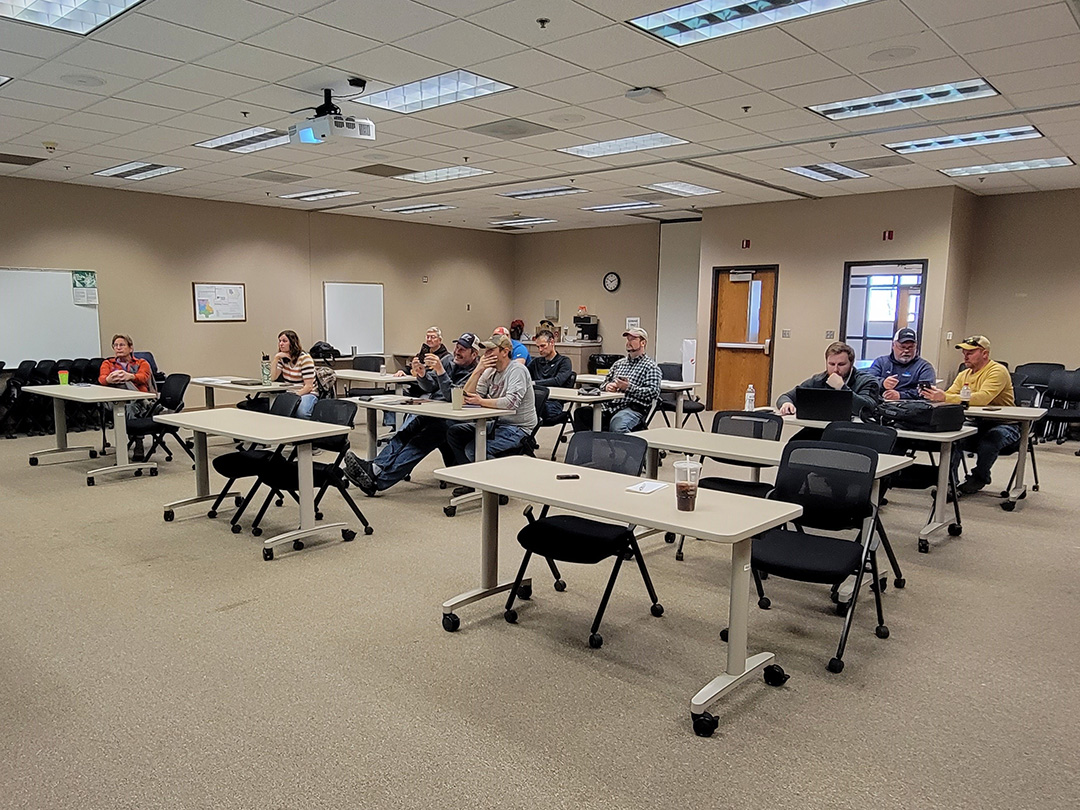
Farmers and industry professionals shared their conservation stories during an Iowa Soybean Association farmer event in Storm Lake last week.(Photo credit: Kriss Nelson/Iowa Soybean Association)
Conservation conversations
March 24, 2022 | Kriss Nelson
Research results, tips to successful cover crop, no-till and strip-till systems were discussed during an event hosted by the Iowa Soybean Association in Storm Lake last week.
Ryan Johnson, ISA conservation agronomist, held the meeting to help bring more awareness to conservation in his area, hoping more farmers will adapt to change.
“The seven most expensive words in agriculture are ‘it’s the way we’ve always done it,’” says Johnson.
Johnson, who works with farmers and staff in the AgState territories, also used the meeting to introduce himself as a conservation agronomist and highlighted some benefits of conservation agriculture and tips to incorporate those practices while still earning a profit.
“The time, fuel and equipment savings from no-till is one benefit,” says Johnson. “With cover crops, there are cost-share programs available and an added value of grazing livestock on those acres.”
Conservation agriculture can also help with water management.
“It could be during a drought and conserving moisture from not tilling and leaving a cover to help prevent evaporation or being able to hold moisture in times of heavy rains,” Johnson says. “We are getting bigger rains and need to handle the uptake of more water, so we have less runoff. Conservation agriculture can help do this.”
Conversations
ISA farmer-members Mike Ehlers of Marathon and Eric Price of Laurens not only shared their conservation story but took part in an active discussion with other farmers and industry professionals in the audience.
“Anytime I have the opportunity to promote conservation and share our experiences, I am always glad to,” says Ehlers.
Whether on their own or through ISA, on-farm trials can help farmers better understand what conservation practices work best on their farms.
“Dip your toes in. Try different things,” says Ehlers. “Right now, it is voluntary. I would hate to see it become mandatory, so it is best if we can figure out conservation while it is still voluntary.”
Price cares about soil conservation and is always willing to do what he can to help other farmers out.
“If you can get at least one more person to be a little open-minded to trying new things on their farm, that’s worth my time,” says Price.
Although conservation is a significant focus on both of their farms, Price and Ehlers have as many differences.
“It was interesting to hear somebody else’s point of view and hear how they do things differently than you do,” says Price. “There is no one right way to do things. You need to figure out what works best for your farm. Be open-minded about new practices and give things a try.”
Sharing results
Scott Nelson, ISA senior field services program manager, shared research results from ISA’s Research Center for Farming Innovation.
“I always appreciate how ISA does their tests and trials,” says Ehlers, who participates in water-monitoring testing in cooperation with ISA.
Nelson’s discussion included yields found in studies of early planted soybeans with a normal relative maturity (RM) and a later RM compared to an expected planting date with average maturity and later RM.
In three years, those results show an advantage of getting soybeans planted earlier. A subject that caught the audience’s attention and allowed for some discussion.
Nelson also highlighted variable-rate nitrogen studies conducted by the RCFI team.
“As expensive as fertilizer is this year, trying to get the biggest bang for the nitrogen we apply will be very important,” says Johnson.
If you missed the event and would like more information on adopting conservation practices or participating in on-farm trials, contact Scott Nelson at snelson@iasoybeans.com or 515-729-8207 or Ryan Johnson at rjohnson@iasoybeans.com or 712-229-7184.
Back